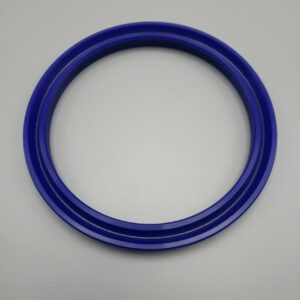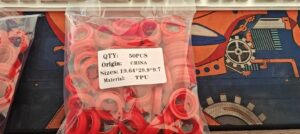Table of Contents
ToggleHow Long Do Hydraulic Seals Last?
The lifespan of hydraulic seals is not a fixed value but depends on a combination of material properties, operating conditions, maintenance practices, and installation quality. This article provides a detailed analysis of expected service life, critical influencing factors, and strategies to maximize longevity.


Lifespan Estimates by Material
Hydraulic seals are manufactured from various materials, each with distinct durability profiles. Below are typical lifespans under standard conditions:
1. Nitrile Rubber (NBR/Buna-N)
- Average Lifespan: 1–5 years.
- Conditions:
- Optimal in moderate-temperature environments (-35°C to +100°C).
- Degrades rapidly when exposed to ozone, high temperatures (>100°C), or incompatible fluids (e.g., brake fluids, ketones).
- Applications: Agricultural machinery, automotive hydraulics.
2. Fluorocarbon Rubber (FKM/Viton®)
- Average Lifespan: 3–8 years.
- Conditions:
- Withstands high temperatures (-20°C to +200°C) and aggressive chemicals.
- Vulnerable to steam and certain esters.
- Applications: Aerospace, chemical processing equipment.
3. Polyurethane (PU)
- Average Lifespan: 2–6 years.
- Conditions:
- Excellent for high-pressure systems but prone to brittleness in extreme cold (<-30°C).
- UV exposure accelerates aging.
- Applications: Hydraulic cylinders, construction equipment.
4. PTFE (Teflon®)
- Average Lifespan: 5–15+ years.
- Conditions:
- Chemically inert and thermally stable (-200°C to +260°C).
- Requires spring reinforcement due to low elasticity.
- Applications: Aggressive chemical systems, high-speed hydraulics.
5. Hydrogenated Nitrile (HNBR)
- Average Lifespan: 3–7 years.
- Conditions:
- Enhanced heat (-40°C to +150°C) and chemical resistance compared to NBR.
- Ideal for automotive and industrial systems.
Key Factors Affecting Seal Longevity
1. Operating Conditions
- Temperature: Exceeding a material’s thermal range causes hardening, cracking, or softening.
- Pressure: High-pressure systems increase wear on seal lips.
- Fluid Compatibility: Incompatible fluids (e.g., biodiesel with NBR) lead to swelling or chemical degradation.
2. Contamination
- Abrasive particles in hydraulic fluid accelerate wear. Adherence to ISO 4406 cleanliness standards is critical.
3. Installation Quality
- Misalignment, damaged grooves, or improper tools during installation can reduce lifespan by 50% or more.
4. Dynamic vs. Static Use
- Reciprocating or rotating seals (e.g., in cylinders) degrade faster than static seals.
5. Environmental Exposure
- UV radiation, ozone, and moisture degrade NBR and PU but minimally affect FKM or PTFE.
Maintenance Strategies to Extend Lifespan
- Regular Inspections:
- Check for leaks, cracks, or hardening during routine maintenance.
- Fluid Management:
- Use clean, dry hydraulic fluid and replace filters regularly.
- Avoid Dry Running:
- Ensure proper lubrication before system startup.
- Temperature Control:
- Install cooling/heating systems to maintain fluid within the seal’s thermal range.
- Proper Storage:
- Store spare seals away from UV light, ozone, and extreme temperatures.
Signs of Seal Failure
- Leakage: Visible fluid seepage around seals.
- Increased Friction: Overheating or erratic cylinder movement.
- Material Degradation: Brittle or cracked seals due to aging or thermal stress.
- Contamination: Debris in hydraulic fluid indicating seal wear.
Industry Benchmarks & Real-World Scenarios
- Mobile Hydraulics (Excavators/Backhoes):
- Average lifespan: 2–4 years due to harsh outdoor conditions.
- Industrial Machinery:
- PTFE/FKM seals may last 5–10 years with rigorous maintenance.
- Aerospace:
- High-performance seals (PTFE/FKM) can exceed 10+ years with frequent inspections.
- Heavy-Duty Applications:
- Severe conditions (e.g., mining) may reduce lifespan to a few hundred operating hours.
Lifespan in Operating Hours
- Standard Conditions: 2,000–3,000 hours.
- Optimal Conditions: 5,000+ hours (contamination-free, low-stress environments).
- Harsh Environments: As low as 100–500 hours in extreme pressure, temperature, or contamination.
Conclusion
Hydraulic seals typically last 1–15+ years or 100–5,000+ operating hours, depending on material, application, and care. Key takeaways include:
- Material Choice: PTFE and FKM excel in extreme environments; NBR and PU suit cost-sensitive uses.
- Maintenance: Regular inspections and fluid management are critical.
- Installation: Proper alignment and tools prevent premature failure.
For precise lifespan estimates, consult manufacturer guidelines (e.g., Parker Hannifin, SKF) or leverage condition-based monitoring tools.



Leave A Comment